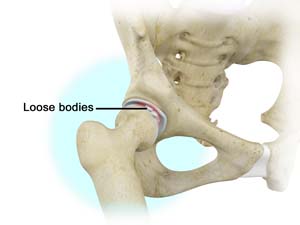
What are Loose Bodies in the Knee?
Loose bodies are fragments of detached cartilage or bone inside the knee joint. These fragments may be free floating (unstable) or may be trapped (stable) within the joint. Depending on the severity, you may have one or more loose bodies in your knee joint.
Causes of Loose Bodies in the Knee
You may develop loose bodies in the knee if:
- You have suffered a knee injury.
- You have a degenerative joint disease such as arthritis.
- You overuse the knee joint due to work or sports.
Symptoms of Loose Bodies in the Knee
You may experience the below symptoms if you have loose bodies in the knee.
- Knee pain.
- Swelling (rare).
- Limited movement of the joint.
- Grating sound (crepitus) with knee movement.
- A sensation of catching or locking in the joint.
- Feeling of something moving in the knee.
Complications of Loose Bodies in the Knee
Left untreated, loose bodies may damage the articular cartilage resulting in osteoarthritis.
Diagnosis of Loose Bodies in the Knee
Your doctor may ask questions about your health, both past and present, and follow-up with a physical examination of your knee.
Imaging tests of the knee are ordered such as:
- X-ray: Typically, the first test to look for loose bodies in the knee.
- CT scan: Higher-definition images for a more detailed view.
- MRI: Provides a detailed image of nonbony tissue.
- Arthrography: An X-ray of the knee after a dye has been injected into the joint.
This helps your doctor determine how severe your condition is and the kind of treatment you would need.
Treatment of Loose Bodies in the Knee
It is important to treat the condition early to prevent cartilage damage. In less severe cases, non-surgical options such as physical therapy and anti-inflammatory pain medications may help to keep your knee joint flexible. However, in most cases, surgical removal of the loose bodies is required.
The surgery of choice in most cases is knee arthroscopy (“clean out” arthroscopy). It is a minimally invasive surgery and typically results in fewer complications. It further allows your doctor to asses any damage to the cartilage and to repair the condition. It is best suitable for removing smaller loose bodies.
Large loose bodies that cannot be removed via arthroscopy are treated by open surgery or arthrotomy. However, this is rare.
Following surgery, a rehabilitation program may be required to restore movement and strength to the knee.
Related Topics
- Knee Osteoarthritis
- Knee Fracture
- Fractures of the Tibia
- Fractures of the Patella
- Knee Pain
- Meniscal Tears
- Knee Angular Deformities
- Quadriceps Tendon Rupture
- Patellar Tendon Rupture
- Kneecap Bursitis
- Knee Injury
- Iliotibial Band Syndrome
- Unstable Knee
- Meniscal Injuries
- Osteonecrosis of the Knee
- Articular Cartilage Injury
- Loose Bodies in the Knee
- Patellar Tendinitis





